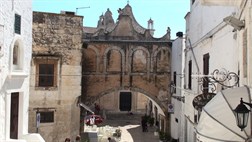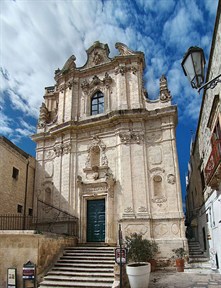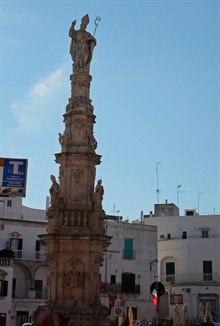Ostuni
 A city rich in history and monuments and works of art related to different artistic styles and at different periods in its history, Ostuni is another of the landmarks of the Baroque in the Salento region. Mixed with the Romanesque, a flourishing Gothic (e.g that of the Co-Cathedral of Santa Maria dell’Assunzione), and nineteenth-century Neo-classicism, the Baroque stands out in the labyrinth of small streets of the old town, which run under the arches (image 1) and go to the sides of illustrious palaces decorated with coats of arms and Baroque balconies. Worthy of note, in particular, are the ducal Zevallos palace and the portals, carved in local stone and inserted in the white walls, the Falgheri Palace, the Ghionda -Pomes Palace, Casa Molendino and Bisantizzi palace.
A city rich in history and monuments and works of art related to different artistic styles and at different periods in its history, Ostuni is another of the landmarks of the Baroque in the Salento region. Mixed with the Romanesque, a flourishing Gothic (e.g that of the Co-Cathedral of Santa Maria dell’Assunzione), and nineteenth-century Neo-classicism, the Baroque stands out in the labyrinth of small streets of the old town, which run under the arches (image 1) and go to the sides of illustrious palaces decorated with coats of arms and Baroque balconies. Worthy of note, in particular, are the ducal Zevallos palace and the portals, carved in local stone and inserted in the white walls, the Falgheri Palace, the Ghionda -Pomes Palace, Casa Molendino and Bisantizzi palace.
 A typical example of Baroque art is the complex formed by the Carmelite monastery and the church of San Vito Martire, dating back to the years 1750-1752. The church, in particular, presents a magnificent undulating façade (image 2), characterized by a broken pediment, a central window and dome polychrome tiles. Inside, the magnificent Baroque altars of Francesco Morgese and the seventeenth-century wooden pulpit stand out. Even the Church of the Annunziata, built at the end of the twelfth century, has Baroque elements which were introduced by the Reformed Friars Minor during the seventeenth century. In the interior, noteworthy are the altars, including one in wood by Giuseppe Morgese, several wooden and stone statues and some paintings, including the Deposition of Paolo VeronesePaolo Caliari, better known as Paolo Veronese (1528-1588), was a Renaissance painter. Born in Verona (hence the name Veronese) he lived for a time at the court of the Gonzaga of Mantua and then moved to Venice in 1556. Assisted in the activity of the workshop by his sons Carlo and Gabriele, Caliari was only partly influenced by the Venetian milieu, while maintaining his distinctive Mannerist style..
A typical example of Baroque art is the complex formed by the Carmelite monastery and the church of San Vito Martire, dating back to the years 1750-1752. The church, in particular, presents a magnificent undulating façade (image 2), characterized by a broken pediment, a central window and dome polychrome tiles. Inside, the magnificent Baroque altars of Francesco Morgese and the seventeenth-century wooden pulpit stand out. Even the Church of the Annunziata, built at the end of the twelfth century, has Baroque elements which were introduced by the Reformed Friars Minor during the seventeenth century. In the interior, noteworthy are the altars, including one in wood by Giuseppe Morgese, several wooden and stone statues and some paintings, including the Deposition of Paolo VeronesePaolo Caliari, better known as Paolo Veronese (1528-1588), was a Renaissance painter. Born in Verona (hence the name Veronese) he lived for a time at the court of the Gonzaga of Mantua and then moved to Venice in 1556. Assisted in the activity of the workshop by his sons Carlo and Gabriele, Caliari was only partly influenced by the Venetian milieu, while maintaining his distinctive Mannerist style..
 The most representative monument of Ostuni is still the Spire of Sant’Oronzo (Saint Orontius, picture 3), more than twenty meters high, located in the heart of the city, close to Piazza Libertà. It was built in 1771 by architect Giuseppe GrecoGiuseppe Greco (1740-1807) was an architect born in Ostuni. as a votive offering by the faithful who wanted to thank the saint for the protection afforded to the city against the plague and famine: this act of devotion is evidenced by inscriptions, supported by angels and placed in front of each of the four faces. The rich Baroque decorations present a balustrade with molded columns on which the statues of the minor patron saints of the lower city: Saints Blaise, Anthony of Padua, Irene and Gregory of Armenia rest in the four corners. Higher up, the orders tend to taper, decorated with putti, cherubs and scrolls. The statue of Sant’Oronzo dominates from on high as he blesses the people.
The most representative monument of Ostuni is still the Spire of Sant’Oronzo (Saint Orontius, picture 3), more than twenty meters high, located in the heart of the city, close to Piazza Libertà. It was built in 1771 by architect Giuseppe GrecoGiuseppe Greco (1740-1807) was an architect born in Ostuni. as a votive offering by the faithful who wanted to thank the saint for the protection afforded to the city against the plague and famine: this act of devotion is evidenced by inscriptions, supported by angels and placed in front of each of the four faces. The rich Baroque decorations present a balustrade with molded columns on which the statues of the minor patron saints of the lower city: Saints Blaise, Anthony of Padua, Irene and Gregory of Armenia rest in the four corners. Higher up, the orders tend to taper, decorated with putti, cherubs and scrolls. The statue of Sant’Oronzo dominates from on high as he blesses the people.
